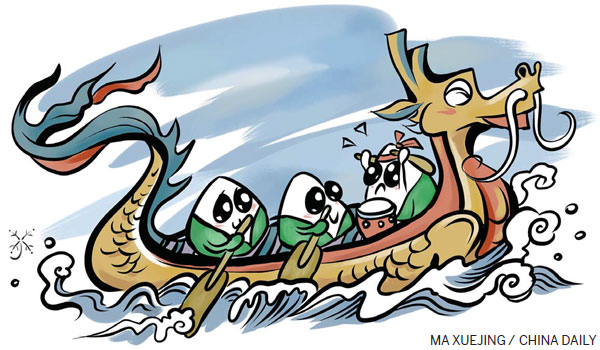Food is China's intangible cultural heritage
The nation has rich and elaborate culinary customs, arguably richer than most other countries

It is widely considered that zongzi, or rice dumplings, is a key traditional symbol that has remained linked with the Dragon Boat Festival. Festivals and food are made for each other in China. Therefore, Chinese cultural authorities should apply for a UNESCO Intangible Cultural Heritage title for Chinese food to better convey the message of traditional Chinese culture.
French food was recognized as a UNESCO Intangible Cultural Heritage in 2010. The recognition or listing has nothing to do with a country's cuisine - nothing to do with the variety of dishes and cooking techniques. Instead it associated with the cultural tradition of eating and drinking. In the case of France, the title was bestowed on the flamboyance of its gastronomy (the dressing of the table, the pairing of certain wines with certain dishes, the placement of glasses and cutlery, the artistry and presentation of a multi-course meal).
In the communique, UNESCO lauded the traditional French meal as a "social custom aimed at celebrating the most important moments in the lives of individuals and groups".
China, too, has rich and elaborate food customs, arguably richer than most other countries, even France, perhaps. In China, an array of dishes is placed on round tables with an elevated, revolving surface that covers the center of the table (the purpose of the revolving table is to allow every diner access to all the dishes as the elevated part is nudged along in circles).
The ritual starts with the preparation of the table - each person gets a saucer and a bowl, a pair of chopsticks, a cup for tea and a shot glass for alcohol - and continues with the progress of the meal. After waiters fill the cups with tea, the diners raise a toast before tucking into the food. The first course is of cold dishes, followed by a variety of hot (as in temperature) dishes, with steamed rice being served toward the end. The array of Chinese dishes is impressive, varying more in ingredients, cooking techniques and flavors than in any other cuisine.
At Chinese banquets or social dinners, the ritual also extends to the way people toast one another - the way the glass is held at a lower or higher level while clinking signifies social rank and/or seniority. And the use of chopsticks itself is the embodiment of finesse, a fine tradition passed down through generations. It takes a foreigner in China about six months of practice to learn how to use chopsticks with dexterity.
It's also a tradition that goes back hundreds of years - at the Shaanxi Historical Museum in Xi'an there is a mural of a banquet that's 1,300 years old, unearthed from a royal tomb of the Tang Dynasty (AD 618-907) - making the Chinese social meal a sophisticated tradition that deserves to be listed as a UNESCO Intangible Cultural Heritage.
The author is a freelance writer who specializes in culture, travel, and lifestyle. The views do not necessarily reflect those of China Daily.


















